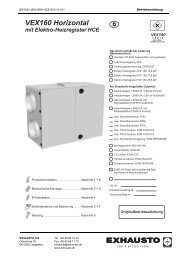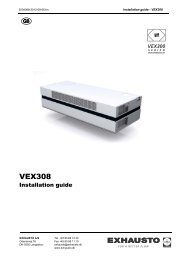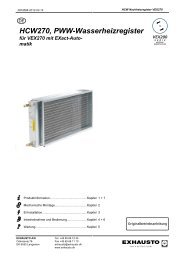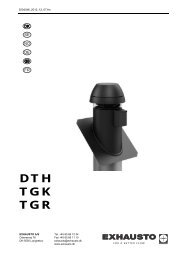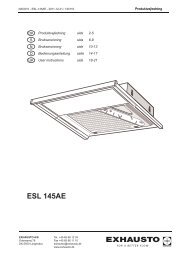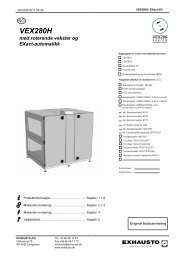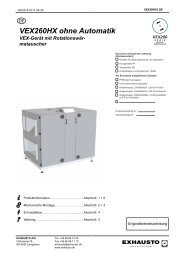ESL130WFC - exhausto.de
ESL130WFC - exhausto.de
ESL130WFC - exhausto.de
You also want an ePaper? Increase the reach of your titles
YUMPU automatically turns print PDFs into web optimized ePapers that Google loves.
EXHAUSTO 3002324 / 123161 / 20030502 / PMH<br />
UK<br />
DESCRIPTION<br />
The ESL 130 WFC is a mo<strong>de</strong>rn cooker hood for fitting in<br />
or un<strong>de</strong>r top cabinets or spice racks, or between top<br />
cabinets. The cooker hood features a built-in control<br />
panel on the front. The cooker hood is to be used in<br />
connection with a centrally located extraction fan for the<br />
entire resi<strong>de</strong>nce. The fan should always run at minimum<br />
speed. The ESL 130 WFC has a built-in motor-controlled<br />
damper that can be adjusted for basic or forced<br />
ventilation. The operating panel is used to adjust the<br />
damper and the fan speed.<br />
INSTALLATION<br />
The channelling of exhaust air must be carried out in<br />
accordance with the applicable regulations from the<br />
relevant authorities. The exhaust air must not be<br />
channelled to any duct that is used to extract flue gases<br />
from any equipment fuelled by energy other than<br />
electricity such as gas or oil fires, wood-burning stoves<br />
and the like.<br />
Fitting the cooker hood, fig. 2<br />
Use the screws provi<strong>de</strong>d to fit the cooker hood.<br />
The cooker hood can be positioned un<strong>de</strong>r or built into a<br />
top cabinet.<br />
The distance between the stove and the cooker hood<br />
must be at least 50 cm. For gas cookers, this distance<br />
must be at least 65 cm. Then fit the appropriate length of<br />
Spiro tube. Affix it carefully and tightly to the cooker hood<br />
spigot.<br />
Accessories - Fitting brackets, fig. 3<br />
Fitting brackets can be used to mount the cooker hood.<br />
These brackets are available as accessories. The fitting<br />
brackets are supplied with fitting instructions.<br />
Electrical installation, fig. 10 (page 22)<br />
This installation must be carried out by an<br />
authorised electrical fitter.<br />
The supply cable must be attached and the cooker hood<br />
must be connected to the electricity supply via an allpole<br />
cut-off switch, minimum length of break: 3 mm.<br />
Changing the current from the transformer<br />
On <strong>de</strong>livery, the settings are:<br />
Basic ventilation 100V<br />
Forced, wet room 230V<br />
1 Forced, kitchen 100V<br />
2 Forced, kitchen 130V<br />
3 Forced, kitchen 230V<br />
Remove the glass light panel and the filter cassette.<br />
Loosen the four screws in the bottom panel. Tilt<br />
downwards and pull forwards. (see fig. 4 and electrical<br />
diagram fig. 11 on page 22).<br />
Initial adjustment of the airflow<br />
On <strong>de</strong>livery, the damper in the cooker hood is set to:<br />
Basic ventilation 20 l/s (72 m³/h) at 120 Pa<br />
Damper setting B 4.3<br />
Noise pressure level = 27 dB(A)<br />
Forced ventilation 40 l/s (144 m³/h) at 100 Pa<br />
Damper setting A 3.7<br />
Noise pressure level = 32 dB(A)<br />
The noise pressure level does not inclu<strong>de</strong> any noise from<br />
the fan. To fine tune the airflow settings, follow the<br />
instructions in the section entitled “Damper settings”.<br />
1<br />
480<br />
2<br />
3<br />
4<br />
22<br />
190 50<br />
13<br />
Torx str. 10<br />
125<br />
18<br />
40<br />
80<br />
598<br />
299<br />
9,5<br />
375 50<br />
16 38 30<br />
96<br />
109<br />
50<br />
35<br />
175



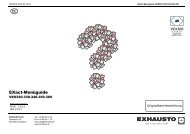
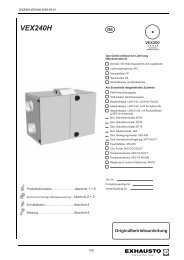
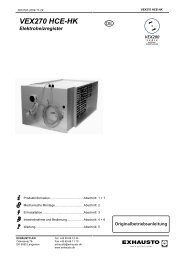
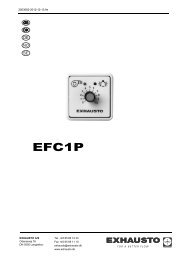
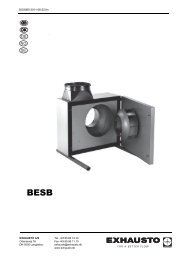
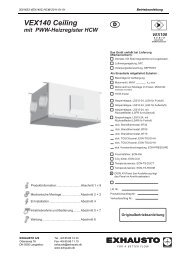
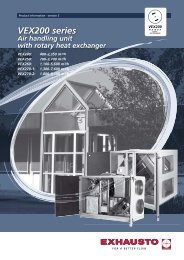
![3003415_ins_vex270hx_de.pdf [Download] - exhausto.de](https://img.yumpu.com/8086300/1/184x260/3003415-ins-vex270hx-depdf-download-exhaustode.jpg?quality=85)
